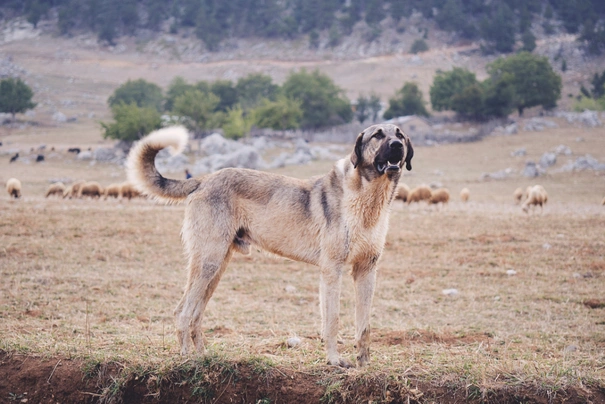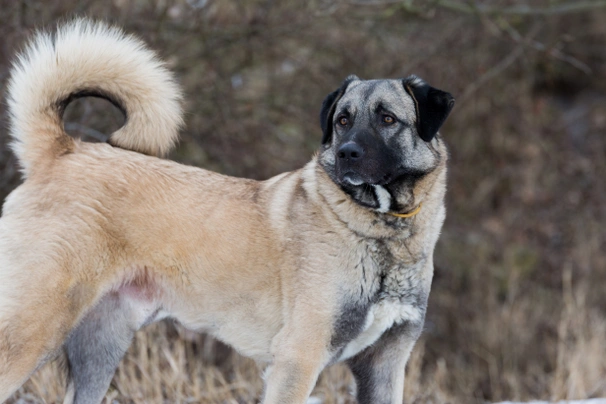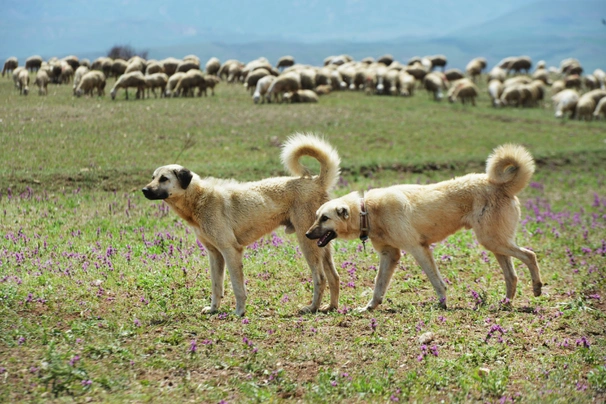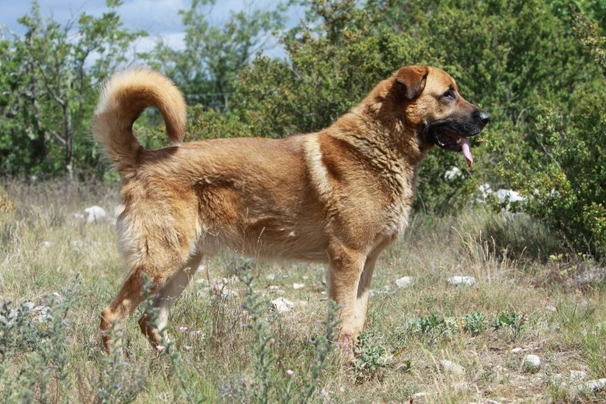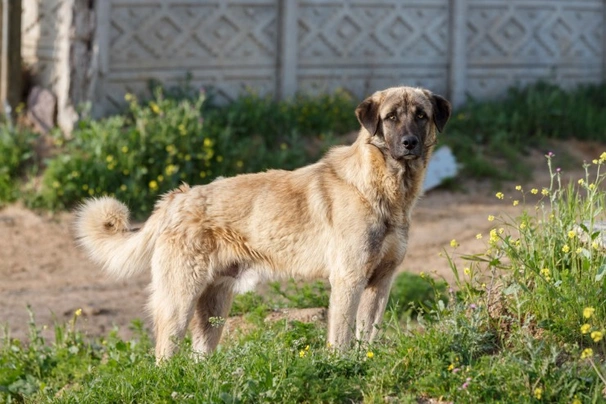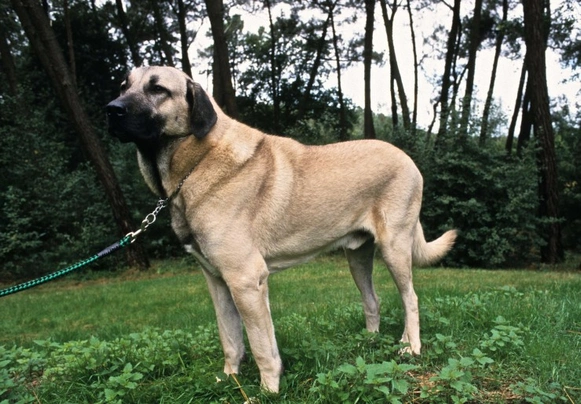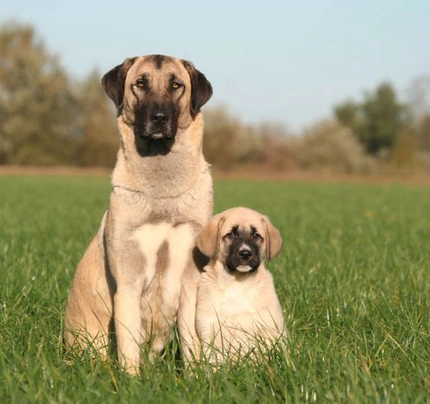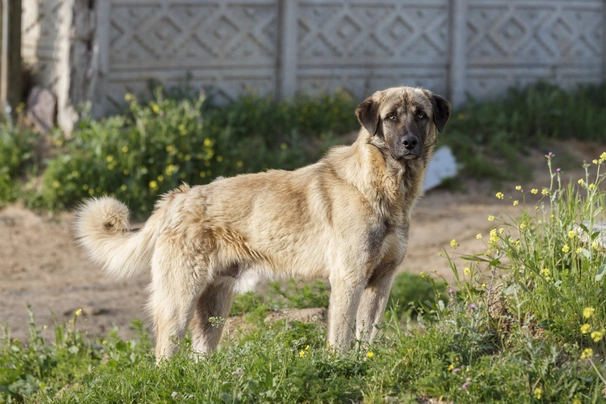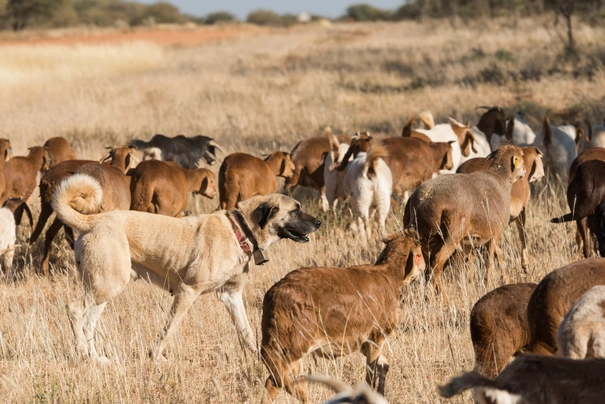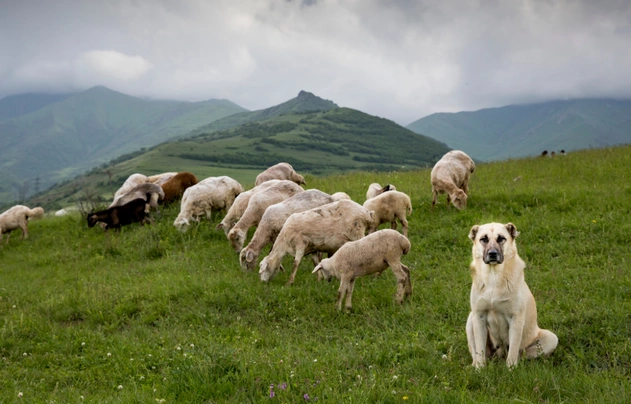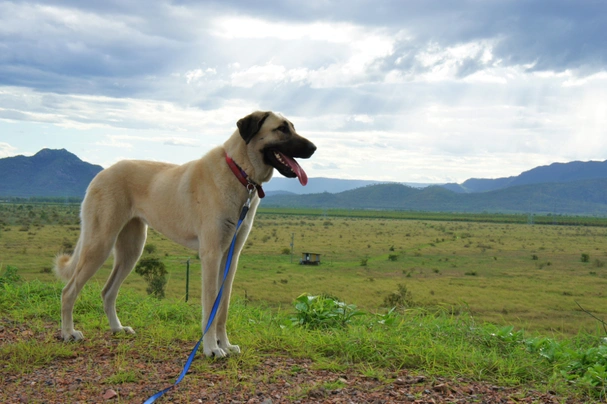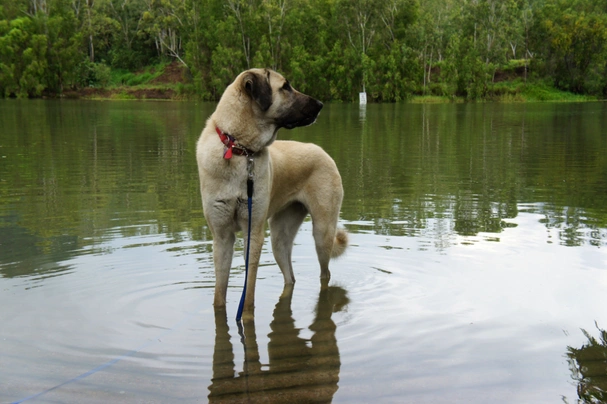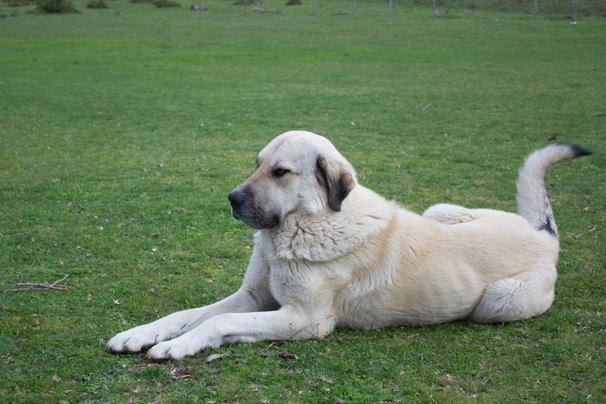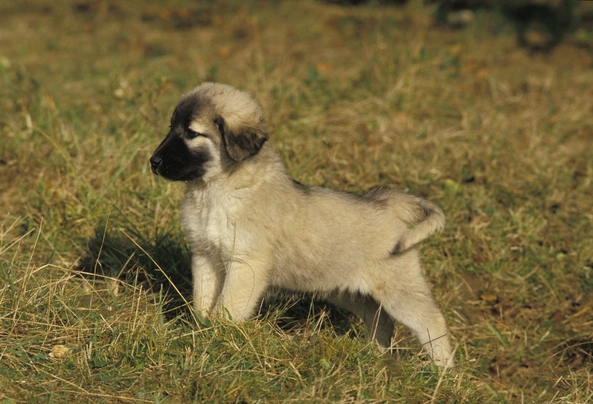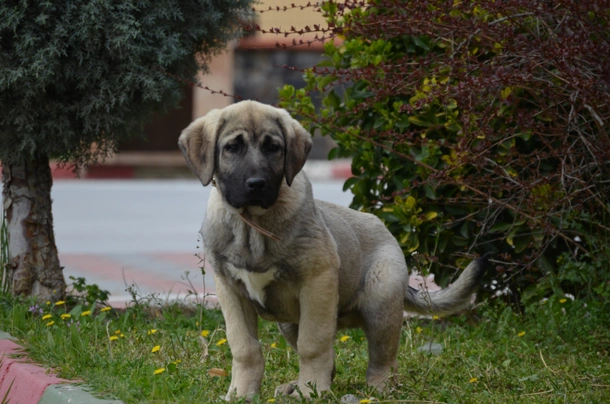Anatolian Shepherd
Pros
Cons
Introduction of the Anatolian Shepherd
The Anatolian Shepherd Dog is native to Turkey where they were bred to guard livestock. They are often called Turkish Mountain Dogs resemble mastiff-types with the difference being they have a distinctive black mask and black ears. The breed is thought to be among the more ancient with an ancestry that dates as far back as 6000 years.
These dogs have found a big fan base in the United States but are less popular here in the UK with very few puppies being registered with The Kennel Club over the last few years. Anyone wanting to share a home with an Anatolian Shepherd would have to go on a waiting list because finding a pedigree dog can be challenging.
History of the Anatolian Shepherd
The Anatolian Shepherd is a giant breed that was bred and developed to work and live alongside man guarding large flocks of livestock over challenging terrains. The breed is thought to be over 6000 years old having originated in Asia. With this said the Anatolian Shepherd as a breed boasts having its roots in 11th century Turkey first appearing on the Anatolian Peninsular around that time. The exact origins of the breed are subject to much debate but over the years many regional variations were developed all thought to have descended from what is known as the Kangal Dog so named for the region in Turkey where they first appeared.
Turkish shepherds at that time needed a strong independent thinking dog to help them guard their large flocks of goats and sheep. They called their dogs Çoban köpegi which translated from Turkish means "shepherd dogs". They had to be hardy because they stayed with their flocks in all weathers which included when there was thick snow on the ground. These shepherd's dogs also needed to be strong and courageous so they could stand their ground and beat off larger predators while guarding their flocks.
These dogs were so highly prized that if anyone killed one they would have to pay the owner a certain amount of grain which had to be as tall as they Anatolian they killed which was measured by hanging a dog by its tail to the ground. Back in ancient times it was a case of the survival of the fittest which meant that only the best dogs were kept and bred from but thanks to the size of the region there were many varieties of Anatolians which saw dogs with different coloured coats and distinct characteristics.
Although as previously mentioned Anatolians lived alongside man they were never kept as pets. There are stories of Turkish farmers placing a collar studded with spikes around a dog's neck to help them fend off predators and today many of these striking dogs still wear this type of collar in their native Turkey. Very few female dogs were kept and when they were they remained in the settlements or villages whereas 2 to 3 male Anatolians would be taken to guard livestock. It was also common practice to only keep the best puppies and to cull the rest. Shepherds would also cut off a young working dog's ears to prevent them from being torn off by predators which could lead to serious infections flaring up.
Anatolians were seldom fed by their shepherds and were expected to find their own food which they did very successfully. Never would an Anatolian attack the herd they were guarding to find food no matter how hungry they are.
Whatever their true history the Anatolian Shepherd dog became popular in the west in the 1970's and more especially in the US where they still boast a big fan base. The breed was first recognised by the American Kennel Club in 1995 and then afterwards here in the UK although Anatolian Shepherds are still rarely seen over here. They are however Turkey's national dog and a Kennel Club recognised breed.
Interesting facts about the breed
- Is the Anatolian Shepherd a vulnerable breed? No already still quite rare in the UK which means that not many puppies are registered with the Kennel Club every year. As such anyone wanting to share a home with an Anatolian would need to register their interest with breeders for the pleasure of doing so
- Anatolians have throughout time been highly prized in Turkey not only for their superb guarding abilities but also for their loyal and devoted natures
- They are direct descendants of an ancient mastiff breed that was native to the Middle East
- Anatolian Shepherds have an amazing scenting ability
- They are very large dogs but they are renowned for being “gentle giants”
Appearance of the Anatolian Shepherd
Height at the withers: Males 74 – 81cm Females 71 – 79 cm
Average weight: Males 50 – 65 kg Females 40 – 55 kg
The Anatolian Shepherd is an impressive and imposing mastiff-type dog. They are powerfully built and tall with unusual and distinctive darker face masks that ensures they stand out in the crowd. Their heads are large and broad with dogs having a slight crease between their eyes and a slight stop. Males have broader heads than their female counterparts. Their lips are slightly pendulous and both lips and nose are black in colour.
Their eyes can be golden right through to brown in colour and quite small in relation to the size of a dog's head. They are set wide apart and quite deep with nice black rims. Ears are moderately big and triangular being rounded at the very tip. Dogs carry their ears flat to their heads and they hang down although when a dog is excited or alert they hold their ears slightly higher. They have a strong jaw with a perfect scissor bite where their upper teeth neatly overlap their lower ones.
Their neck is powerful and well-muscled with dogs holding it slightly arched and their shoulders are muscular nicely sloping. Front legs are straight well boned and set well apart. The Anatolian has a deep chest and well sprung ribs with a nice level topline and slightly arched loins. Bellies are neatly tucked up adding to their athletic powerful appearance.
Hindquarters are strong but lighter than a dog's forequarters with back legs being well muscled. Their feet are strong with well arched toes and short nails. Tails are long and set high which dogs carry low with a very slight wave in it when relaxed but they carry them high with the tip curled up when they are excited or alert which is especially true of male dogs.
When it comes to their coat the Anatolian Shepherd boasts a short thick coat with a dense undercoat that lies flat to the body. The hair is slightly thicker and longer around a dog's neck on their shoulders and tail but without any feathering on legs or ears. All colours are permissible and dogs can have a black mask and ears or not. The accepted breed colours for Kennel Club registration are as follows:
- Fawn with Mask
- Grey Fawn with Mask
- Red Fawn with Mask
- Tricolour
- White No Mask
Gait/movement
When an Anatolian Shepherd moves they do so with a relaxed powerful and supple gait. They hold their heads high and straight showing a tremendous amount of drive in their hindquarters.
Faults
The Kennel Club frowns on any exaggerations or departures from the breed standard and would judge the faults on how much they affect a dog's overall health and wellbeing as well as their ability to perform.
Males should have both testicles fully descended into their scrotums and it is worth noting that a dog can be a little lighter or heavier as well as slightly taller or shorter than set out in the Kennel Club breed standard which is only given as a guideline.
Temperament of the Anatolian Shepherd
The Anatolian Shepherd is slow to mature with males only really coming of age when they are around 4 years old whereas their female counterparts mature a little earlier when they are around three years of age. They are not the best choice for first time owners because these dogs need to be handled and trained by someone who is family with the breed or this type of large and impressive dog. Despite their large size in the right hands the Anatolian Shepherd is known to be a gentle and calm dog. They are hardy and boast long life spans but they can be quite territorial simply because it's in their nature to guard and protect.
They are also highly intelligent and independent which means they need to be well socialised when young to curb their natural guarding instinct. If a dog is allowed to display this type of behaviour it can lead to problems later on in a dog's life. They can be quite vocal at times but only when they hear any unfamiliar sounds or are aware of something they don't like in their environment. They tend to be wary of people they don't know although rarely an Anatolian Shepherd show any aggression towards strangers. With this said they form strong bonds with their owners and families.
Are they a good choice for first time owners?
Anatolian Shepherds are not a good choice for novice dog owners because they need to be socialised handled and trained by people who are familiar with the specific needs of such a large independent thinking and intelligent dog. Anatolians will take over if they are allowed and will be the dominant force in a household which can make living with them extremely hard.
What about prey drive?
Anatolians do not have a high prey drive and will only chase another animal on the rare occasion or when they feel threatened. As such they can usually be trusted around livestock and other pets simply because it is in their nature to "protect" rather than hurt. There are stories of female Anatolians nursing lambs and other baby animals which shows just how low they prey drive is.
What about playfulness?
The Anatolian Shepherd is not as playful as many other breeds because they take their "job" very seriously. Even when puppies they are not generally as "bouncy" but this is not to say that they don't have their mad moments when the mood takes them.
What about adaptability?
Being such large dogs Anatolians need to have enough room to express themselves as they should which means they are better suited to people who have large high fenced secure back gardens that a dog can roam in whenever possible. This allows them to let off steam when they want and need to.
What about separation anxiety?
Although Anatolians form strong ties with their families and they have a strong need to guard and protect them they are not known to suffer from separation anxiety because they are so independent by nature.
What about excessive barking?
Anatolians are not known to be "barkers" and will generally only voice an opinion when they feel the need to which is typically when something they don't like goes on around them or when there are strangers about.
Do Anatolian Shepherds like water?
Most Anatolians like swimming and will take to the water whenever they can more especially when the weather is hot. However if anyone who owns a dog that does not like water should never force them to go in because it would just end up scaring them. With this said care should always be taken when walking a dog off the lead anywhere near more dangerous watercourses just in case a dog decides to leap in or they fall in and then need rescuing because they cannot get out of the water on their own.
Are Anatolian Shepherds good watchdogs?
Anatolians are natural protectors and do not need to be trained to take care or watch over their families because this is a trait that is deeply embedded in their psyche. Their impressive size alone is enough to put most wrongdoers off when they first see an Anatolian.
Intelligence / Trainability of the Anatolian Shepherd
Because they are so strong willed they can be quite hard to train especially if their education does not start early enough in their lives. It takes a great deal of patience consistency and an understanding of the breed to train an Anatolian Shepherd and even then there is no guarantee of these dogs being 100% obedient. It cannot be stressed enough the importance of socialising puppies from a young age so as mature dogs they are more tolerant of things and this includes being around other dogs.
Like all puppies Anatolian puppies are very cute and it's easy to forget that they soon grow up to be very large dogs. As such once a puppy is settled in a new home owners must start out as they mean to go on bearing in mind that Anatolians are dominant dogs by nature and will take advantage of things if allowed which includes being "alpha dog" in a household. Rules and boundaries must be laid out so that a puppy understands what is expected of them which also helps establish a "pecking order". The first commands a puppy must be taught are as follows:
- Come
- Sit
- Stay
- Heel
- Quiet
- Leave it
- Down
- Bed
Children and other
Anatolian Shepherd Dogs are known to be gentle when they are around children however their size alone can be a bit of a problem. Care should be taken when they are near very small children and toddlers because they might just knock them over albeit by accident which could result in frightening or even injuring a child. In short they are not the best choice for people with very young families although an Anatolian Shepherd would never hurt a small child on purpose.
They can be aggressive towards other dogs which is especially true of males even if they have been well socialised from a young age. Any contact with other small animals and pets which includes cats should be avoided because an Anatolian Shepherd's instinct might get the better of them with disastrous results.
Health of the Anatolian Shepherd
The average life expectancy of an Anatolian Shepherd is between 13 and 15 years when properly cared for and fed an appropriate good quality diet to suit their ages.
The breed is known to be hardy and therefore they do not seem to suffer from the many hereditary and congenital disorders that plague a lot of other pedigree dogs. With this said they are known to suffer from hip dysplasia which dogs can be DNA tested for and if the results come back positive they should not be used in a breeding programme.
- Hip dysplasia - dogs should be hip scored
- Elbow dysplasia - dogs should be tested
- Congenital deafness - test available through the Animal Health Trust (AHT)
- Osteochondritis dissecans
- Epilepsy
- Cardiomyopathy
- Autoimmune thyroiditis
- Bloat/gastric torsion
What about vaccinations?
Anatolian puppies would have been given their initial vaccinations before being sold but it is up to their new owners to make sure they have their follow-up shots in a timely manner with the vaccination schedule for puppies being as follows:
- 10 -12 weeks old bearing in mind that a puppy would not have full protection straight away but would be fully protected 2 weeks after they have had their second vaccination
There has been a lot of discussion about the need for dogs to have boosters. As such it's best to talk to a vet before making a final decision on whether a dog should continue to have annual vaccinations which are known as boosters.
What about spaying and neutering?
A lot of vets these days recommend waiting until dogs are slightly older before spaying and neutering them which means they are more mature before undergoing the procedures. As such they advise neutering males and spaying females when they are between the ages of 6 to 9 months old and sometimes even when a dog is 12 months old.
Other vets recommend spaying and neutering dogs when they are 6 months old but never any earlier unless for medical reasons. With this said many breeds are different and it is always advisable to discuss things with a vet and then follow their advice on when a dog should be spayed or neutered.
What about obesity problems?
Like other breeds Anatolians may gain weight after they have been spayed or neutered and it's important to keep an eye on a dog's waistline just in case they do. If a dog starts to put on weight it's important to adjust their daily calorie intake and to up the amount of exercise they are given. Older dogs too are more prone to gaining weight and again it's essential they be fed and exercised accordingly because obesity can shorten a dog's life by several years. The reason being that it puts a lot of extra strain on a dog's internal organs including the heart which could prove fatal.
What about allergies?
Some Anatolians are prone to suffering from allergies and it's important for a dog to see a vet sooner rather than later if one flares up. Allergies can be notoriously hard to clear up and finding the triggers can be challenging. With this said a vet would be able to make a dog with an allergy more comfortable while they try to find out the triggers which could include the following:
- Certain dog foods that contain high levels of cereal and other grain-like fillers
- Airborne pollens
- Dust mites
- Environment
- Flea and tick bites
- Chemicals found in everyday household cleaning products
Participating in health schemes
All responsible Anatolian Shepherd breeders would ensure that their stud dogs are tested for known hereditary and congenital health issues known to affect the breed by using the following schemes:
- Hip dysplasia - dogs should be hip scored
- Elbow dysplasia - dogs should be tested
- Congenital deafness - test available through the Animal Health Trust (AHT)
What about breed specific breeding restrictions?
Apart from the standard breeding restrictions for all Kennel Club recognised breeds there are no other breed specific breeding restrictions in place for the Anatolian Shepherd.
What about Assured Breeder Requirements?
It is mandatory for all Kennel Club Assured Breeders to use the following test on their dogs and all other breeders are strongly advised to follow suit:
Caring for the Anatolian Shepherd
As with any other breed Anatolian Shepherds need to be groomed on a regular basis to make sure their coats and skin are kept in top condition. They also need to be given regular daily exercise to ensure they remain fit and healthy. On top of this they need to be fed good quality food that meets all their nutritional needs throughout their lives.
Caring for a Anatolian Shepherd puppy
Anatolian puppies are boisterous and full of life which means it's essential for homes and gardens to be puppy-proofed well in advance of their arrival. A responsible breeder would have well socialised their puppies which always leads to more outgoing confident and friendly dogs right from the word go. With this said any puppy is going to feel vulnerable when they leave their mother and littermates which must be taken into account. The longer a puppy can remain with their mother the better although it should never be for too long either.
It's best to pick a puppy up when people are going to be around for the first week or so which is the time needed for a puppy to settle in. Puppy-proofing the home and garden means putting away any tools and other implements that a boisterous puppy might injure themselves on. Electric wires and cables must be put out of their reach because puppies love chewing on things. Toxic plants should be removed from flowerbeds and the home too.
Puppies need to sleep a lot to grow and develop as they should which means setting up a quiet area that's not too out of the way means they can retreat to it when they want to nap and it's important not to disturb them when they are sleeping. It's also a good idea to keep "playtime" nice and calm inside the house and to have a more active "playtime" outside in the garden which means puppies quickly learn to be less boisterous when they are inside.
The documentation a breeder provides for a puppy must have all the details of their worming date and the product used as well as the information relating to their microchip. It is essential for puppies to be wormed again keeping to a schedule which is as follows:
- Puppies should be wormed at 6 months old
- They need to be wormed again when they are 8 months old
- Puppies should be wormed when they are 10 months old
- They need to be wormed when they are 12 months old
Things you'll need for your puppy
There are certain items that new owners need to already have in the home prior to bringing a new puppy home. It's often a good idea to restrict how much space a puppy plays in more especially when you can't keep an eye on what they get up to bearing in mind that puppies are often quite boisterous which means investing in puppy gates or a large enough playpen that allows a puppy the room to express themselves while keeping them safe too. The items needed are therefore as follows:
- Good quality puppy or baby gates to fit on doors
- A good well-made playpen that's large enough for a puppy to play in so they can really express themselves as puppies like to do
- Lots of well-made toys which must include good quality chews suitable for puppies to gnaw on bearing in mind that a puppy will start teething anything from when they are 3 to 8 months old
- Good quality feed and water bowls which ideally should be ceramic rather than plastic or metal
- A grooming glove
- A slicker brush or soft bristle brush
- Dog specific toothpaste and a toothbrush
- Scissors with rounded ends
- Nail clippers
- Puppy shampoo and conditioner which must be specifically formulated for use on dogs
- A well-made dog collar or harness
- A couple of strong dog leads
- A well-made dog bed that's not too small or too big
- A well-made dog crate for use in the car and in the home that's large enough for a puppy to move around in
- Baby blankets to put in your puppy's crate and in their beds for when they want to nap or go to sleep at night
Keeping the noise down
All puppies are sensitive to noise including Anatolian puppies. It's important to keep the noise levels down when a new puppy arrives in the home. TVs and music should not be played too loud which could end up stressing a small puppy out.
Keeping vet appointments
As previously mentioned Anatolian puppies would have been given their first vaccinations by the breeders but they must have their follow up shots which is up to their new owners to organise. The vaccination schedule for puppies is as follows:
- 10 -12 weeks old bearing in mind that a puppy would not have full protection straight away but would only be fully protected 2 weeks after they have had their second vaccination
When it comes to boosters it's best to discuss these with a vet because there is a lot of debate about whether a dog really needs them after a certain time. However if a dog ever needed to go into kennels their vaccinations would need to be fully up to date.
What about older Anatolian Shepherds when they reach their senior years?
Older Anatolians need lots of special care because as they reach their golden years they are more at risk of developing certain health concerns. Physically a dog's muzzle may start to go grey but there will be other noticeable changes too which includes the following:
- Coats become coarser
- A loss of muscle tone
- Anatolians can either become overweight or underweight
- They have reduced strength and stamina
- Older dogs have difficulty regulating their body temperature
- They often develop arthritis
- Immune systems do not work as efficiently as they once did which means dogs are more susceptible to infections
Older dogs change mentally too which means their response time tends to be slower as such they develop the following:
- They respond less to external stimuli due to impaired vision or hearing
- They tend to be a little pickier about their food
- They have a lower pain threshold
- Become intolerant of any change
- Often an older dog can feel disorientated
Living with an Anatolian in their golden years means taking on a few more responsibilities but these are easily managed and should include looking at their diet the amount of exercise they are given how often their dog beds need changing and keeping an eye on the condition of their teeth.
Older Anatolian Shepherds need to be fed a good quality diet that meets their needs at this stage of their lives all the while keeping a close eye on a dog's weight. A rough feeding guide for older dogs is as follows bearing in mind they should be fed highly digestible food that does not contain any additives:
- Protein content should be anything from 14 – 21%
- Fat content should be less than 10%
- Fibre content should be less than 4%
- Calcium content should be 0.5 – 0.8%
- Phosphorous content should be 0.4 – 0.7%
- Sodium content should be 0.2 – 0.4%
Older Anatolians don't need to be given the same amount of daily exercise as a younger dog but they still need the right amount of physical activity to maintain muscle tone and to prevent a dog from putting on too much weight. All dogs need access to fresh clean water and this is especially true of older dogs when they reach their golden years because they are more at risk of developing kidney disorders.
Grooming of the Anatolian Shepherd
Anatolian Shepherds boast thick short coats which means it’s easy to keep them looking tidy. With this said a weekly brush helps get rid of any loose and dead hair. Like other dogs they tend to shed more during the Spring and then again in the Autumn which is when more frequent brushing would be necessary to keep on top of things and their coats looking good.
It's also important to check a dog's ears on a regular basis and to clean them when necessary. If too much wax is allowed to build up in a dog's ears it can lead to a painful infection which can be notoriously hard to clear up. In short prevention is often much easier than cure when it comes to ear infections.
Exercise of the Anatolian Shepherd
Anatolian Shepherds are energetic dogs and they need to be given lots of daily exercise as well as a ton of mental stimulation for them to be truly happy well rounded characters. Ideally these large dogs need to be a minimum of 2 hours a day with a shorter walk first thing in the morning and then a more interesting and longer walk in the afternoon.
They also really benefit from being able to run around a back garden as often as they can so they can really let off steam without being on a lead. However the fencing has to be very secure to keep an Anatolian Shepherd in. As such they would not do well living in an apartment but would thrive in a home that boasts a large and secure back garden.
Feeding of the Anatolian Shepherd
If you get an Anatolian Shepherd puppy from a breeder they would give you a feeding schedule and it's important to stick to the same routine feeding the same puppy food to avoid any tummy upsets. You can change a puppy's diet but this needs to be done very gradually always making sure they don't develop any digestive upsets and if they do it's best to put them back on their original diet and to discuss things with the vet before attempting to change it again.
Older dogs are not known to be fussy or finicky eaters but this does not mean you can feed them a lower quality diet. It's best to feed a mature dog twice a day once in the morning and then again in the evening making sure it's good quality food that meets all their nutritional requirements. It's also important that dogs be given the right amount of exercise so they burn off any excess calories or they might gain too much weight which can lead to all sorts of health issues. Obesity can shorten a dog's life by several years so it's important to keep an eye on their waistline from the word go.
Feeding guide for an Anatolian Shepherd puppy
Puppies need to be fed a highly nutritious good quality diet for them to develop and grow as they should. As a rough guide an Anatolian puppy can be fed the following amounts every day making sure their meals are evenly spread out throughout the day and it's best to feed them 3 or 4 times a day:
- 2 months old - 289g to 399g depending on puppy's build
- 3 months old - 386g to 530g depending on puppy's build
- 4 months old - 429g to 577g depending on puppy's build
- 5 months old - 514g to 701g depending on puppy's build
- 6 months old - 587g to 809g depending on puppy's build
- 7 months old - 589g to 752g depending on puppy's build
- 8 months old - 585g to 824g depending on puppy's build
- 9 months old - 537g to 808g depending on puppy's build
- 10 months old - 501g to 798g depending on puppy's build
- 11 months old - 456g to 684g depending on puppy's build
- 12 months old - 414g to 651g depending on puppy's build
- 13 months old - 411g to 607g depending on puppy's build
- 14 months old - 406g to 564g depending on puppy's build
Once a puppy is 24 months old they can be fed adult dog food.
Feeding guide for an adult Anatolian Shepherd
Once fully mature an adult Anatolian Shepherd should be fed a good quality diet to ensure their continued good health. As a rough guide an adult Anatolian can be fed the following amounts every day:
- Dogs weighing 40 kg can be fed 384g to 509g depending on activity
- Dogs weighing 50 kg can be fed 428g to 593g depending on activity
- Dogs weighing 55 kg can be fed 468g to 633g depending on activity
- Dogs weighing 65 kg can be fed 498g to 663g depending on activity
Anatolian Shepherd price
There are not that many of these dogs being bred here in the UK which means they can be extremely hard to find. With this said you would need to pay anything from £700 to over £1500 for a well-bred pedigree puppy.
The cost of insuring a male 3-year-old Anatolian Shepherd in northern England would be £22.34 a month for basic cover but for a lifetime policy this would set you back £44.13 a month (quote as of February 2018). When insurance companies calculate a pet's premium they factor in several things which includes where you live in the UK and a dog's age and whether they have been neutered or spayed.
When it comes to food costs you need to buy the best quality food whether wet or dry to feed your dog throughout their lives making sure it suits the different stages of their lives. This would set you back between £50 - £60 a month. On top of this you would need to factor in veterinary costs if you want to share your home with an Anatolian Shepherd and this includes their initial vaccinations their annual boosters the cost of neutering or spaying your dog when the time is right and then their yearly health checks all of which quickly adds up to over a £1000 a year.
As a rough guide the average cost to keep and care for an Anatolian Shepherd would be between £80 to £110 a month depending on the level of insurance cover you opt to buy for your dog but this does not include the initial cost of buying a healthy well-bred Kennel Club registered pedigree Anatolian Shepherd puppy.
Buying advice
When visiting and buying any puppy or dog there are many important things to consider and questions to ask of the breeder/seller. You can read our generic puppy/dog advice here which includes making sure you see the puppy with its mother and to verify that the dog has been wormed and microchipped.
Anatolian Shepherds are starting to have a larger fanbase in the UK which means that healthy well-bred puppies can often command a lot of money. As such with Anatolians there is specific advice questions and protocols to follow when buying a puppy which are as follows:
- Beware of online scams and how to avoid them. You may see online and other adverts by scammers showing images of beautiful Anatolian Shepherdpuppies for sale at very low prices. However the sellers ask buyers for money up front before agreeing to deliver a puppy to a new home. Potential buyers should never buy a puppy unseen and should never pay a deposit or any other money online to a seller. You should always visit the pet at the sellers home to confirm they are genuine and make a note of their address.
- As previously touched upon although Anatolian Shepherds are quite rare in the UK they are starting to have a large fanbase. As such there are many amateur breeders/people who breed from a dam far too often so they can make a quick profit without caring for the welfare of the puppies their dam or the breed in general. Under Kennel Club rules a dam can only produce 4 litters and she must be between a certain age to do so. Anyone wishing to buy an Anatolian Shepherd puppy should think very carefully about who they purchase their puppy from and should always ask to see the relevant paperwork pertaining to a puppy's lineage their vaccinations and their microchipping.

